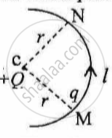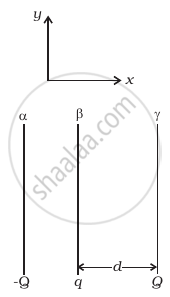Advertisements
Advertisements
प्रश्न
It is now believed that protons and neutrons (which constitute nuclei of ordinary matter) are themselves built out of more elementary units called quarks. A proton and a neutron consist of three quarks each. Two types of quarks, the so called ‘up’ quark (denoted by u) of charge (+2/3) e, and the ‘down’ quark (denoted by d) of charge (−1/3) e, together with electrons build up ordinary matter. (Quarks of other types have also been found which give rise to different unusual varieties of matter.) Suggest a possible quark composition of a proton and neutron.
उत्तर
A proton has three quarks. Let there be n up quarks in a proton, each having a charge of `+2/3"e"`.
Charge due to n up quarks = `(2/3"e")` n
Number of down quarks in a proton = 3 − n
Each down quark has a charge of `-1/3"e"`.
Charge due to (3 − n) down quarks = `(-1/3"e")(3 - "n")`
Total charge on a proton = + e
∴ `"e" = (2/3"e")"n" + (-1/3"e")(3 - "n")`
`"e" = ((2"ne")/3)-"e" + ("ne")/3`
2e = ne
n = 2
Number of up quarks in a proton, n = 2
Number of down quarks in a proton = 3 − n = 3 − 2 = 1
Therefore, a proton can be represented as ‘uud’.
A neutron also has three quarks. Let there be n up quarks in a neutron, each having a charge of `+3/2"e"`.
Charge on a neutron due to n up quarks = `(+3/2"e")"n"`
The number of down quarks is 3 − n, each having a charge of `(-1/3)"e"`.
Charge on a neutron due to `(3 - "n")`down quarks = `(-1/3"e")(3 - "n")`
Total charge on a neutron = 0
`0 = (2/3"e")"n" + (-1/3"e")(3 - "n")`
`0 = 2/3 "en" -"e" + ("ne")/3`
e = ne
n = 1
Number of up quarks in a neutron, n = 1
Number of down quarks in a neutron = 3 − n = 2
Therefore, a neutron can be represented as ‘udd’.
APPEARS IN
संबंधित प्रश्न
Explain the meaning of the statement ‘electric charge of a body is quantised’.
Why can one ignore quantisation of electric charge when dealing with macroscopic i.e., large scale charges?
When a glass rod is rubbed with a silk cloth, charges appear on both. A similar phenomenon is observed with many other pairs of bodies. Explain how this observation is consistent with the law of conservation of charge.
When a charged comb is brought near a small piece of paper, it attracts the piece. Does the paper become charged when the comb is brought near it?
In Figure 1 below, a charge Q is fixed. Another charge q is moved along a circular arc MN of radius r around it, from the point M to the point N such that the length of the arc MN = l. The work done in this process is:

figure 1
Choose the correct option.
Two charges of 1.0 C each are placed one meter apart in free space. The force between them will be
Let x = πR`(("P"^2 - "Q"^2)/2)`, where P, Q and Rare lengths. The physical quantity x is ______.
Conservation of charges in tribo electric charging _________.
Eight dipoles of charge of magnitude ± e are placed inside a cube. The total electric flux coming out of the cube will be:-
A glass rod rubbed with silk is used to charge a gold-leaf electroscope and the leaves are observed to diverge. The electroscope thus charged is exposed to X-rays for a short period. Then ______
The dimensions of an atom are of the order of an Angstrom. Thus there must be large electric fields between the protons and electrons. Why, then is the electrostatic field inside a conductor zero?
A paisa coin is made up of Al-Mg alloy and weighs 0.75g. It has a square shape and its diagonal measures 17 mm. It is electrically neutral and contains equal amounts of positive and negative charges.
Treating the paisa coins made up of only Al, find the magnitude of equal number of positive and negative charges. What conclusion do you draw from this magnitude?
Two fixed, identical conducting plates (α and β), each of surface area S are charged to –Q and q, respectively, where Q > q > 0. A third identical plate (γ), free to move is located on the other side of the plate with charge q at a distance d (Figure). The third plate is released and collides with the plate β. Assume the collision is elastic and the time of collision is sufficient to redistribute charge amongst β and γ.
- Find the electric field acting on the plate γ before collision.
- Find the charges on β and γ after the collision.
- Find the velocity of the plate γ after the collision and at a distance d from the plate β.

A steady current of 8 mA flows through a wire. The number of electrons passing through a cross-section of the wire in 10 s is ______.
